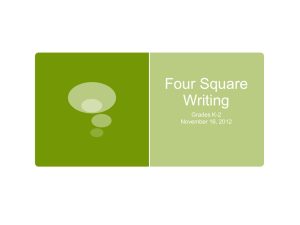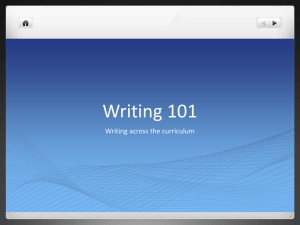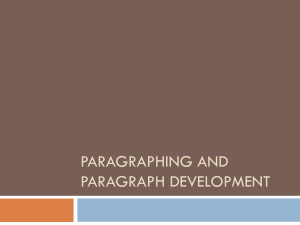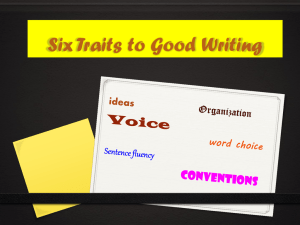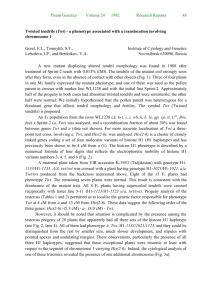The Write Tools PowerPoint - Hollidaysburg Area School District
advertisement
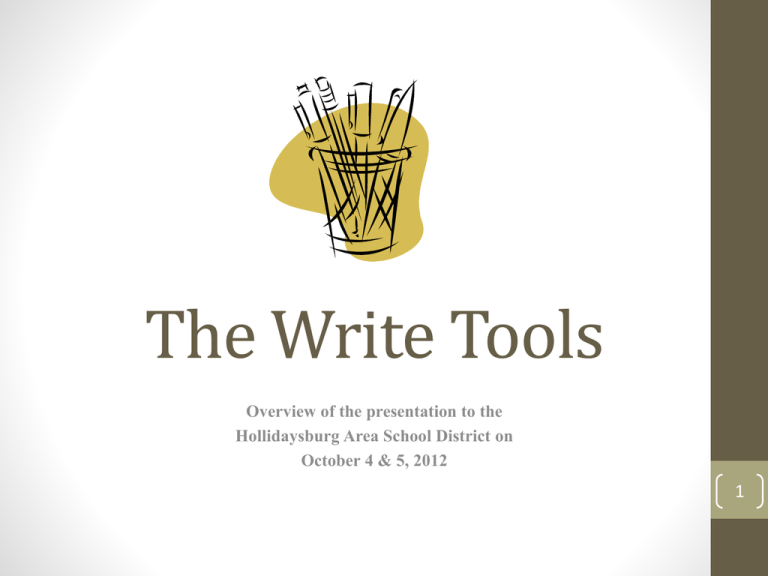
The Write Tools Overview of the presentation to the Hollidaysburg Area School District on October 4 & 5, 2012 1 • The Write Tools (TWT) presents strategies in a three-tiered model, deliberately addressing different levels of writing proficiency rather than grade level. • There are three essential components to improve writing skills. Students must: - receive direct instruction from trained teachers - write every day using a variety of text structures and hearing a common language and terminology - receive feedback on strengths and on what to do next • Level 1 = most basic • Level 2 and 3 = students who are becoming increasingly more proficient writers. Students are learning to enjoy writing and take risks. • TWT makes a deliberate connection to the 6 + 1 Traits ( ideas, organization, word choice, voice, sentence fluency, conventions, presentation). These traits are the foundation of many state and district writing rubrics used to assess student writing. THE WRITE GOALS - philosophy All teachers must share a common goal and a common language for student success. Too often students move from classroom to classroom with teachers using different terminology for the same idea. 2 • Common vision - consistent formative and summative assessment by the classroom teacher provides valuable information for planning • Writing has a direct connection to improving reading comprehension. Organized thinking often forms the text structure around which information text is built. COMMON STRATEGIES COMMON LANGUAGE COMMON VISION CONSISTENT, SYSTEMATIC, EXPLICIT INSTRUCTION = SUCCESS Compatible with Common Core Standards • The English Language Arts Standards emphasize three genres of writing: informative, opinion-persuasive, and narrative. • English teachers should use all of the traits; content-area teachers should use these three: ideas, organization, and word choice (content vocabulary). RECIPE FOR SUCCESS! The classroom teacher is the most important person in the success of this program. 3 • Step 1 – Select a compelling piece of text to read aloud. Read the story ahead of time and make five or six places where you’ll stop for students to write a response. • Step 2 – Read the selection aloud. When you come to a marked place, say “Please respond.” They may write complete sentences, single words or phrases, or draw a picture. • Step 3 – Warn students you will not wait for everyone to finish. A partial response will help them remember what they’re thinking. • Step 4 – When reading and responding cycles are complete, ask students to briefly review their notes. Give students a few minutes to talk to neighbors and discuss their ideas. EXAMPLES OF SAMPLE QUESTIONS: How did this author give us clues about the setting? How does one of the characters remind you of someone you know? What predictions did you make? How did your predictions compare with what the author had to say? EXAMPLES OF FEELING WORDS FOR FREE RESPONSE: Afraid, angry, confused, delighted, discouraged, disgusted, doubted, embarrassed, happy, sad, surprised, wondering, etc. RESPONDING TO READING: Free Response 4 • • • • • Use on the 1st day of school. Start with small group then whole group. Don’t grade. Use one or two a week for awhile. Co-teaching classes should read aloud immediately after writing to encourage others • Use in contents classes as well. • Students can reread response notes and create a chart of the general categories to “think about their reading.” • CONNECTION TO 6 + 1 TRAITS: Ideas that have meaning are based on a combination of the author’s words and the reader’s prior knowledge Sentence fluency Voice FREE RESPONSES: Purpose and Tips 5 • TWT says: “If we start teaching the writing of longer pieces with students who still are not writing in complete sentences, both students and teachers will continued to be frustrated.” • Sentence writing activities: Improve fluency Create more precise and accurate word choice Increase writing time Motive students to move from 3-star writing to 4-star Use generic terms like WHO, ACTION, HOW then move to NOUN, VERB, ADVERB Use word banks for students with limited vocabulary Practice sorting words into categories with index cards Secondary - add phrases and clauses to increase fluency Helps to lead into talking about conventions BUILDING BETTER SENTENCES 6 NUMBER NOTES: List your topic at the top of the plan. Rule of 5 - five words or less for each entry Linear - easy to read Will help with planning for multi-paragraph writing See handout T-CHART: Use printed form; later on, students can fold their papers and draw lines Use a web (quick assessment); have it visible while they’re creating the T-chart Reorganize aloud Practice on a variety of topics Work it backwards – create t-charts from paragraphs See handout INTRODUCTION TO NEW METHODS OF PLANNING Start with a “quick assessment” like a web. Next, reorganize the same information into Number Notes or a T-chart. 7 • Use a variety of paper products (post-it notes, chart paper, index cards , or transparencies). • Practice, practice, practice. • Students don’t always have to proceed to a paragraph. • After lots of practice, have student write a short paragraph examining his or her preference of Number Notes or T-charts. CONNECTION TO 6 + 1 Traits: Organization Ideas Word Choice See handouts on color-coding and level 1, 2, and 3 paragraphs PREWRITING ORGANIZER TIPS 8 • The CORE 4: Simple Declarative Number Statement Question Situation, Stance ( 2-parts) • NO’S FOR TOPIC SENTENCES: Hello, my name is _____. I am going to tell you about______. In this paragraph I am going to tell you about _____. I am going to write about _____. There are _____. Here are _____. • USE TAK: Topic, Audience, and Key Word (see handout) • ALTERNATIVES FOR “THERE ARE”: Use who, how, what, where, and when See page 57 handout. TOPIC SENTENCES 9 • • • • • • • • • • Broadly introduces the topic with a dependent clause Clearly states viewpoint on the topic with an independent clause Sample: “Although teaching is a challenging profession, it is still very rewarding.” Highlight or circle the two parts in different colors. Circle the comma. Emphasize that it is always the second part that clearly states what the paragraph will be about. Start small – only use a few starter words. “Writing it out loud!” Practice creating a lot of these sentences out loud so students can hear as well as see them. Show an incorrect sentence: “Although my mother’s name is Cathy, I am fourteen years old.” For more mature writers, use pg. 15 & 16 for multi-paragraphs. (see handout) • CONNECTION TO 6 + 1 TRAITS: Organization Fluency Conventions – introduces the complex sentence TOPIC SENTENCE: Situation, Stance 10 • Is a list of transition words or expressions readily available to the students in your classroom? • See handouts. • CONNECTION TO 6 + 1 TRAITS: fluency – can the student rearrange the transitions in the sentence? organization – transitions are markers for the READER! CONCLUSIONS: • Summarize the information in the body • Restate the topic but use different words • Encourages reflection or to take a past action • Students must learn to avoid: “Now you know…” and “That is all I have to say.” • Students can use one of the Core 4 that they didn’t use for a topic sentence. • Some conclusion words: actually, as a result, certainly, consequently, definitely, in fact, obviously, in fact, surely, truly • See handouts • CONNECTION TO 6 + 1 TRAITS: organization – conclusions are an expected part of a paragraph word choice – students create synonyms for key words BODY SENTENCES , TRANSITIONS, and CONCLUSIONS Transitions connect ideas together. Teach how to avoid the deadly trio: first, second, third. Teach a variety of words to use for a conclusion. 11 • Use colored pencils. • Check for clarity and word choice. • On chart paper, make a list of kinds of revisions that good writers might make and keep this list posted. • Students should always reread to improve quality of work. • Students should be taught how to be a Peer Revision Partner. • See Paragraph Analysis Forms • See handouts • CONNECTION TO 6 + 1 TRAITS: Word choice - heading Fluency – where are the transitions place in the sentences? Conventions – capitalization and end marks are important in revision • Revision resources: Ruther Heller’s books about parts of speech Barry Lane’s book Reviser’s Toolbox Scholastic has tapes of authors talking about the writing process. REVISION 12 • The editing process provides detailed feedback focused on conventions. • The teacher should recognize ONE strength and ONE next step for the student rather a long list of errors. • See handouts – there are feedback forms for the three levels of writing • Use CUPS – capitalization, usage, punctuation, spelling • The Final Copy – If handwritten, it should be in pencil, with the best handwriting, and be consistent in style. Older students should sometimes use cursive. According to TWT: Although printing is becoming more acceptable in the adult world, students still need to know how to read it! If typed, the paper should have a legible font in black ink no larger than 14. Correct all mistakes in the final edit. TEACHER CONFERENCING 13 1. Copy form two-sided (see handouts) 2. Students must be trained in peer conferencing. 3. Two students should volunteer to conduct a peer conference in front of the class with teachers observing and commenting. 4. Teach students to use the language of the 6 + 1 traits. 5. The students should work quietly, and the sessions should be short. 6. The writer fills out the form; the responder gives feedback orally. 7. Students should keep track in notebooks of peer advice to avoid the same issues over and over. 8. Students don’t need to always use the paragraph analysis form. Turn a piece of paper sideways and fold it into 4, 6, or 8 parts. Keep the paper turned sideways, and write the heading above the red margin line. PEER REVISION PARTNER 14 • In a retell, the student is asked to convey all the big ideas from the selection, we well as many, many details. • A response to literature should include: A short summary paragraph Personal connections (text to self, world, or other text) Author’s message or lesson, including a personal comment • A summary should: Be significantly shorter than the original text Contain significant paraphrasing rather than directly copied words/phrases/sentences Include big ideas in sequential order Eliminate most details (especially insignificant ones) Exclude personal opinion Leave out outside information not in the selection SUMMARY and RETELL and A RESPONSE TO LITERATURE Definitions 15 • Step 1: Create a three-part summary topic sentence. Name It • • • • Step 2: Step 3: Step 4: Step 5: Verb It Big Picture Use jot dots to paraphrase and list big ideas (critical skills for later lesson note-taking) Turn to a neighbor and “Write It Out Loud.” Put the planner on the corner of your desk. Get out a clean sheet of paper. Begin writing your actual summary. Recopy topic sentence to begin the summary. Stretch the jot dots into complete sentences. Check off each item on the plan as it is included in the summary. • List of verbs for summaries: LEVEL 1 LEVEL 2 LEVEL 3 shows tells compares, describes, discusses, explains, explores, Illustrates, lists, shows, teaches, tell acknowledges, adds, advises, answers, asks, asserts, assures, blames, captures, clarifies, classifies, confirms, confronts, confuses, considers, contrasts, critiques, defends, defines, demonstrates, denounces, depicts, discourages, encourages, endorses, entertains, entices, evaluates, explores, expresses, features, furnishes, identifies, illustrates, invites, judges, misjudges, names, offends, offers, praises, predicts, presents, proposes, provides, recommends, simplifies, solves, suggests, supports, traces STEPS for SUMMARIES 16 • Start with fiction books that you read aloud. Why? You’re teaching the strategy first. Don’t overload with instruction from a complicated story. Practice with anything they’ve read, watched, or listened to. • Give students many opportunities to practice three-part topic sentences before adding jot dots. Do lots on chart paper, one sentence per sheet. Then, pull out the chart papers with just the threepart topic sentences on them and add the jot dots to each selection when students are ready for that step. Provide the topic sentence and have students add jot dots. • Summary writing gives students a natural opportunity to show their comprehension of what they’ve read. • Practice paraphrasing. First dot: important event from beginning Middle dot: important events in sequential order Last dot: ending of story • CONNECTION TO 6 + 1 TRAITS: Ideas Organization Word Choice Sentence Fluency WRITING A SUMMARY Model, model, and model some more! 17 1. 2. 3. 4. 5. Show students samples of strong, real-life writing. Have students color code with green, yellow, and pink. Show students how certain sentences remain the same no matter how long the piece. A multiparagraph paper begins with an introductory paragraph (an introductory or thesis paragraph). NOTE: The instructor said that the phrase “thesis statement” does not appear anywhere in the CCSS. Introductory Paragraph - Topic Sentence - Preview Statement Body Paragraph 1 Body Paragraph 2 Body Paragraph 3 Concluding Paragraph - Summarize - Restate - Think/Do Quick Overview of Multiparagraph Writing – part 1 18 New paragraphs start when there is a change in T Time S Scene S Subject S Speaker Background Sentences (“the hook”) Anecdotes Humor Dialogue History Startling fact/statement Question Quote • See handouts CONNECTION TO 6 + 1 TRAITS: Ideas Word Choice Sentence Fluency Organization Voice Conventions Presentation Quick Overview of Multiparagraph Writing – part 2 19


